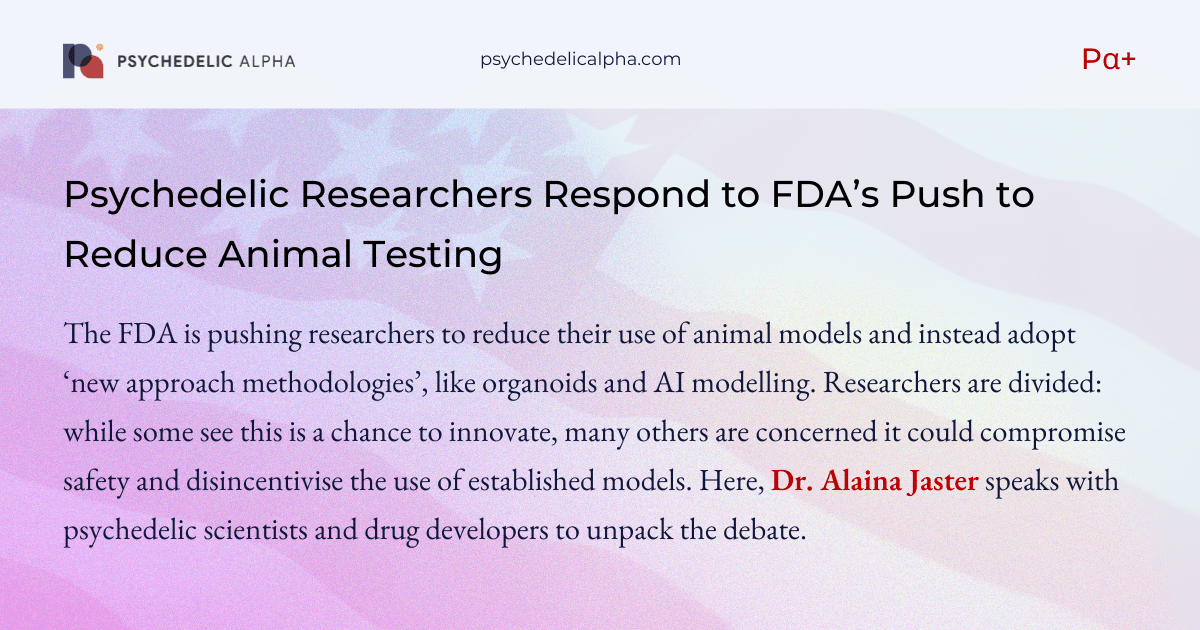The FDA is pushing researchers to reduce their use of animal models and instead adopt ‘new approach methodologies’, like organoids and AI modelling. Researchers are divided: while some see this as a chance to innovate, many others are concerned it could compromise safety and disincentivise the use of established models. Here, Dr. Alaina Jaster speaks with psychedelic scientists and drug developers to unpack the debate.
***
Scientific research in the United States has faced a large degree of uncertainty in the first six months of the second Trump Administration. Following mass layoffs at government agencies, proposed budget cuts of 40-60%, and the reduction of indirect costs to just 10-15% for agencies including the National Institutes of Health (NIH) and National Science Foundation (NSF), another blow was handed down from the administration.
Among these changes, in early April, the U.S. Food and Drug Administration (FDA) and NIH, both offices of the U.S. Department of Health and Human Services (HHS), announced initiatives to reduce animal testing in research related to drug and monoclonal antibody therapies.
This announcement came with a push for the field to move towards the use of “new approach methodologies”, or NAMs. Some examples include organoids, artificial intelligence, computational modelling, and other advanced in vitro technologies.
The notice boasts the move will “improve drug safety and accelerate the evaluation process, while reducing animal experimentation, lowering research and development costs, and ultimately, drug prices.” The Interagency Coordinating Committee on the Validation of Alternative Methods (ICCVAM), originally formed in 2000, will be in charge of these processes.
Some of these changes may spark innovation in the field, like the use of advanced computer simulations to predict drug behaviour and interactions. Methodology like this already exists and, in some cases, uses human post-mortem toxicology reports or patient reports to create decision trees that identify dangerous drug-drug interactions.
“People have been talking about doing this for so long,” said Dr. Sam Banister, Co-founder and CSO of neuroplastogen developer Xylo Bio. “At least in the tox[icology] space, given what happened with thalidomide. But I still can’t ever see a situation in the near future where we have good enough computational or other models to do away with that end of things.”
The use of computational modelling has also already been a part of drug discovery. For example, using highly sophisticated techniques like crystallography, scientists have been able to model how psychedelic and non-psychedelic drugs bind to different serotonin receptors in the brain, inducing their effects. In combination with in vitro functional experiments using human-derived cells that express serotonin receptors, many researchers are able to create novel compounds. The question that is being raised by many is: What happens after drug discovery?
On the other side of the coin, some scientists don’t seem too worried about the change, and may even be excited for the opportunity to explore new methods.
Dr. Bryan Roth, a molecular pharmacologist, recently posted an article on Substack about how psychedelic experiments can be conducted without animal models, showing “cruelty-free plots” of functional receptor data using human embryonic kidney cells that express serotonergic receptors. In his blog, he explores the use of predictive modelling within the psychedelics space and suggests that, with replication, it could be useful.
The FDA hosted a workshop on Monday, July 7, 2025, where it provided more information on the move away from animal testing. This included the suggestion of organoids and organ-on-a-chip systems, which are reported to “mimic human organs” and provide a system to test toxicology that can be “undetected in animals.”
These models are useful for identifying direct effects on organs, such as how administration of a novel psychedelic would directly impact valvulopathy in the heart. But, as most drugs are not applied directly to organ systems and are administered systemically, there is concern that skipping animal safety tests could be dangerous…
Sign-in or join Pα+ to continue reading this article…
Join Pα+ Today
Independent data-driven reporting, analysis and commentary on the psychedelics space: from business and drug development through to policy reform and culture.
Already a member? Log In
✓ Regular Bulletins covering key topics and trends in the psychedelics space
✓ Regular articles and deep dives across psychedelic research, policy and business
✓ Interviews with insiders
✓ Monthly interactive database and commentary on psychedelic patents
✓ Quick-take analysis of major developments
✓ A Library of primers and explainers
✓ Access to our full back catalogue


